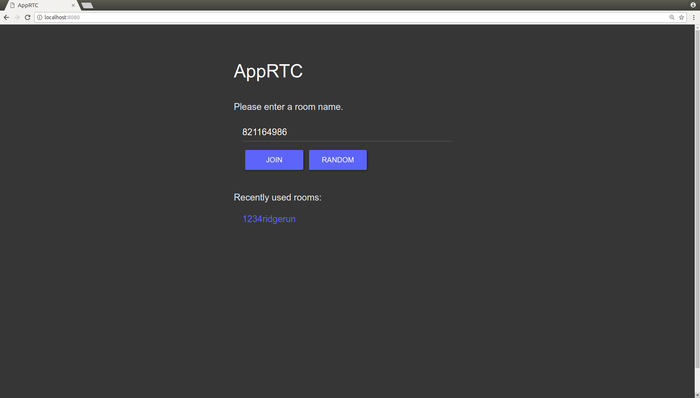GstWebRTC - AppRTC Web Page - x86
| GstWebRTC | ||||||||
|---|---|---|---|---|---|---|---|---|
 | ||||||||
| WebRTC Fundamentals | ||||||||
| GstWebRTC Basics | ||||||||
|
||||||||
| Evaluating GstWebRTC | ||||||||
| Getting the code | ||||||||
| Building GstWebRTC | ||||||||
| Examples | ||||||||
|
||||||||
| MCU Demo Application | ||||||||
| Contact Us |
This page presents some AppRTC Web page on x86 platform to use AppRTC.
|
|
Contents
Server Setup
To run the examples first enable the Websocket server:
$GOPATH/bin/collidermain -port=8089 -tls=false
Then, enable the AppRTC Node server in a different terminal window:
cd <PATH>/apprtc-node-server
node ./bin/www
Note: Make sure you previously install dependencies needed for enable the servers, if you didn't, follow this link:
Setup AppRTC Node Server with our websocket server
AppRTC WebPage
The following figure show how to establish a call using the AppRTC web page created locally in http://localhost:8080/
To open the Webside in Chrome, disable security running the following command:
google-chrome-stable --unsafely-treat-insecure-origin-as-secure=http://webrtc.ridgerun.com:8080 --user-data-dir=/tmp/foo
- Type a unique Session ID in the text bar.
- Press join
Note: To execute the following examples, first run the pipeline and then, press join with the correct session ID. Also make sure you reset AppRTC Node server every time you execute a WebRTC communication with the AppRTC Web Page.
x264 Send+Receive
Example
This pipeline will encode a video stream to H264 and send it to the demo web page. Additionally, it will receive the web page's video feed, in the same format.
gst-launch-1.0 rrwebrtcbin start-call=true signaler=GstApprtcSignaler signaler::server_url=http://localhost:8080 \
signaler::session_id=1234ridgerun name=web \
videotestsrc is-live=true ! queue ! videoconvert ! x264enc key-int-max=1 ! rtph264pay ! queue ! web.video_sink \
web.video_src ! rtph264depay ! avdec_h264 ! videoconvert ! ximagesink async=true
x264+OPUS Send+Receive
Example
This pipeline will send an audio and a H264 video streams the demo web page. Additionally, it will receive the web page's streams, in the same format.
gst-launch-1.0 rrwebrtcbin start-call=true signaler=GstApprtcSignaler signaler::server_url=http://localhost:8080 \
signaler::session_id=1234ridgerun name=web \
videotestsrc is-live=true ! queue ! videoconvert ! x264enc key-int-max=1 ! rtph264pay ! queue ! web.video_sink \
web.video_src ! rtph264depay ! avdec_h264 ! videoconvert ! ximagesink async=true \
audiotestsrc is-live=true wave=8 ! audioconvert ! audioresample ! queue ! opusenc ! rtpopuspay ! web.audio_sink \
web.audio_src ! rtpopusdepay ! opusdec ! audioconvert ! alsasink async=false
VP8 Send+Receive
Example
This pipeline will encode a video stream to VP8 and send it to the demo web page. Additionally, it will receive the web page's video feed, in the same format.
gst-launch-1.0 rrwebrtcbin start-call=true signaler=GstApprtcSignaler signaler::server_url=http://localhost:8080 \
signaler::session_id=1234ridgerun name=web \
videotestsrc is-live=true ! vp8enc ! rtpvp8pay ! web.video_sink \
web.video_src ! rtpvp8depay ! vp8dec ! videoconvert ! ximagesink async=true
VP8+OPUS Send+Receive
Example
This pipeline will send an audio and a Vp8 video streams the demo web page. Additionally, it will receive the web page's streams, in the same format.
gst-launch-1.0 rrwebrtcbin start-call=true signaler=GstApprtcSignaler signaler::server_url=http://localhost:8080 \
signaler::session_id=1234ridgerun name=web \
videotestsrc is-live=true ! vp8enc ! rtpvp8pay ! web.video_sink \
web.video_src ! rtpvp8depay ! vp8dec ! videoconvert ! ximagesink async=true \
audiotestsrc is-live=true wave=8 ! audioconvert ! audioresample ! queue ! opusenc ! rtpopuspay ! web.audio_sink \
web.audio_src ! rtpopusdepay ! opusdec ! audioconvert ! alsasink async=false
